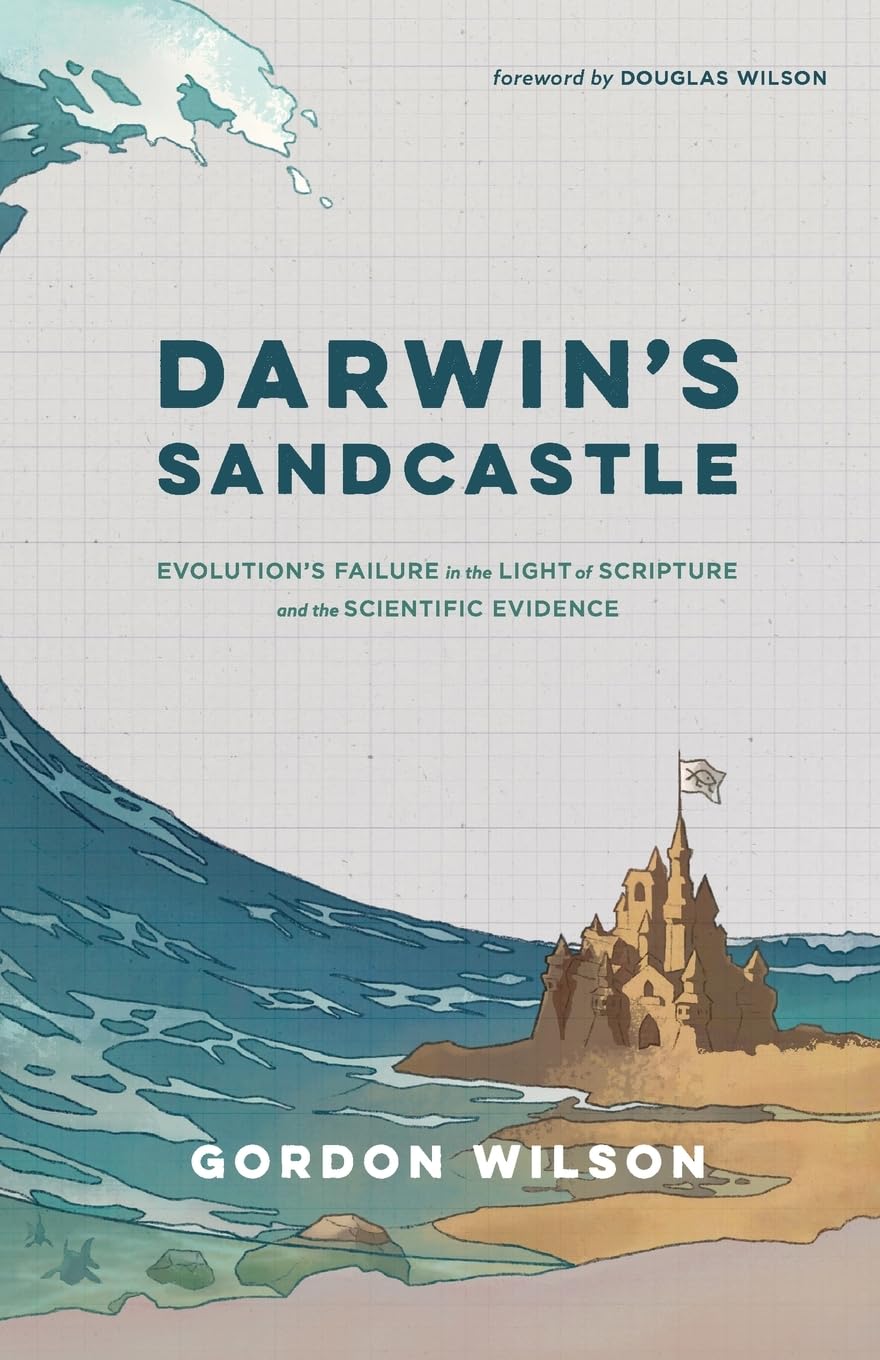January 2022
Subscribe to Dialogue
FEATURED BOOKS AND DVDS
Paperback / $22.00 / 138 Pages / full colour
Textbooks routinely present the examples of Darwin’s finches and the peppered moths as demonstrations of evolution in action and thus, by implication, proof for the truth of evolution. These cases are supposed to be star examples of how natural selection drives populations to new more complex levels of body organization. Nevertheless, when we look, we find that these cases involve only oscillating changes in very small characteristics. These populations never change from peppered moths and finches. We find in these situations, nothing like the major inputs of new information which would be needed to produce basic new architectures (body plan) in these organisms. That situation would be real evolution, but it does not happen. See natural selection and blueprint, peppered moths.
British evolutionary biologist David Lack proposed that finches living on the Galapagos Islands, were a good example of evolutionary divergence. There are 29 major islands as well as many small rocky outcrops in this archipelago. The distances between islands tend to be small. Thirteen species of finch (in 2 genera) live on these islands. Up to 10 species live together on one island, and no real island has only one species. [David Lack. 1953. Darwin’s Finches. Scientific American. 188 #4 pp. 66-71). From the time of this publication on, Darwin’s finches have been a popular example of evolution in action. However, nobody had any clear ideas how development of new species might actually happen.
Enter Peter and Rosemary Grant from Princeton University who really put Darwin’s finches on the map. From 1972-2001, they studied the only 2 finch populations on Daphne Major, a small island of about 100 acres. The study subjects were Geospiza fortis and G. scandens (the medium ground finch and the cactus finch, respectively). At times of drought, there was a die off of birds with small beaks and the surviving birds had larger thicker beaks, better able to crack large seeds. But when the rains returned, the populations reverted to their former composition of birds with small beaks as well as birds with larger beaks. The Grants saw this cycle repeated many times through the years. After 14 years they stopped studying the G. scandens population because it was mating with the other species and its distinctive characteristics were disappearing.
So what did they observe after 30 years on Daphne Major? Zero evolution. Natural selection ensured that the population was fine-tuned for location conditions. There was no major input of information proceeding towards new body plans. Alas for that textbook example of evolution in action!
Order OnlinePaperback / $6.00 / 55 Pages
Textbooks routinely present the examples of Darwin’s finches and the peppered moths as demonstrations of evolution in action and thus, by implication, proof for the truth of evolution. These cases are supposed to be star examples of how natural selection drives populations to new more complex levels of body organization. Nevertheless, when we look, we find that these cases involve only oscillating changes in very small characteristics. These populations never change from peppered moths and finches. We find in these situations, nothing like the major inputs of new information which would be needed to produce basic new architectures (body plan) in these organisms. That situation would be real evolution, but it does not happen. See natural selection and blueprint, peppered moths.
British evolutionary biologist David Lack proposed that finches living on the Galapagos Islands, were a good example of evolutionary divergence. There are 29 major islands as well as many small rocky outcrops in this archipelago. The distances between islands tend to be small. Thirteen species of finch (in 2 genera) live on these islands. Up to 10 species live together on one island, and no real island has only one species. [David Lack. 1953. Darwin’s Finches. Scientific American. 188 #4 pp. 66-71). From the time of this publication on, Darwin’s finches have been a popular example of evolution in action. However, nobody had any clear ideas how development of new species might actually happen.
Enter Peter and Rosemary Grant from Princeton University who really put Darwin’s finches on the map. From 1972-2001, they studied the only 2 finch populations on Daphne Major, a small island of about 100 acres. The study subjects were Geospiza fortis and G. scandens (the medium ground finch and the cactus finch, respectively). At times of drought, there was a die off of birds with small beaks and the surviving birds had larger thicker beaks, better able to crack large seeds. But when the rains returned, the populations reverted to their former composition of birds with small beaks as well as birds with larger beaks. The Grants saw this cycle repeated many times through the years. After 14 years they stopped studying the G. scandens population because it was mating with the other species and its distinctive characteristics were disappearing.
So what did they observe after 30 years on Daphne Major? Zero evolution. Natural selection ensured that the population was fine-tuned for location conditions. There was no major input of information proceeding towards new body plans. Alas for that textbook example of evolution in action!
Order OnlineHardcover / $52.00 / 433 Pages
Textbooks routinely present the examples of Darwin’s finches and the peppered moths as demonstrations of evolution in action and thus, by implication, proof for the truth of evolution. These cases are supposed to be star examples of how natural selection drives populations to new more complex levels of body organization. Nevertheless, when we look, we find that these cases involve only oscillating changes in very small characteristics. These populations never change from peppered moths and finches. We find in these situations, nothing like the major inputs of new information which would be needed to produce basic new architectures (body plan) in these organisms. That situation would be real evolution, but it does not happen. See natural selection and blueprint, peppered moths.
British evolutionary biologist David Lack proposed that finches living on the Galapagos Islands, were a good example of evolutionary divergence. There are 29 major islands as well as many small rocky outcrops in this archipelago. The distances between islands tend to be small. Thirteen species of finch (in 2 genera) live on these islands. Up to 10 species live together on one island, and no real island has only one species. [David Lack. 1953. Darwin’s Finches. Scientific American. 188 #4 pp. 66-71). From the time of this publication on, Darwin’s finches have been a popular example of evolution in action. However, nobody had any clear ideas how development of new species might actually happen.
Enter Peter and Rosemary Grant from Princeton University who really put Darwin’s finches on the map. From 1972-2001, they studied the only 2 finch populations on Daphne Major, a small island of about 100 acres. The study subjects were Geospiza fortis and G. scandens (the medium ground finch and the cactus finch, respectively). At times of drought, there was a die off of birds with small beaks and the surviving birds had larger thicker beaks, better able to crack large seeds. But when the rains returned, the populations reverted to their former composition of birds with small beaks as well as birds with larger beaks. The Grants saw this cycle repeated many times through the years. After 14 years they stopped studying the G. scandens population because it was mating with the other species and its distinctive characteristics were disappearing.
So what did they observe after 30 years on Daphne Major? Zero evolution. Natural selection ensured that the population was fine-tuned for location conditions. There was no major input of information proceeding towards new body plans. Alas for that textbook example of evolution in action!
Order OnlinePaperback / $28.00 / 256 Pages
Textbooks routinely present the examples of Darwin’s finches and the peppered moths as demonstrations of evolution in action and thus, by implication, proof for the truth of evolution. These cases are supposed to be star examples of how natural selection drives populations to new more complex levels of body organization. Nevertheless, when we look, we find that these cases involve only oscillating changes in very small characteristics. These populations never change from peppered moths and finches. We find in these situations, nothing like the major inputs of new information which would be needed to produce basic new architectures (body plan) in these organisms. That situation would be real evolution, but it does not happen. See natural selection and blueprint, peppered moths.
British evolutionary biologist David Lack proposed that finches living on the Galapagos Islands, were a good example of evolutionary divergence. There are 29 major islands as well as many small rocky outcrops in this archipelago. The distances between islands tend to be small. Thirteen species of finch (in 2 genera) live on these islands. Up to 10 species live together on one island, and no real island has only one species. [David Lack. 1953. Darwin’s Finches. Scientific American. 188 #4 pp. 66-71). From the time of this publication on, Darwin’s finches have been a popular example of evolution in action. However, nobody had any clear ideas how development of new species might actually happen.
Enter Peter and Rosemary Grant from Princeton University who really put Darwin’s finches on the map. From 1972-2001, they studied the only 2 finch populations on Daphne Major, a small island of about 100 acres. The study subjects were Geospiza fortis and G. scandens (the medium ground finch and the cactus finch, respectively). At times of drought, there was a die off of birds with small beaks and the surviving birds had larger thicker beaks, better able to crack large seeds. But when the rains returned, the populations reverted to their former composition of birds with small beaks as well as birds with larger beaks. The Grants saw this cycle repeated many times through the years. After 14 years they stopped studying the G. scandens population because it was mating with the other species and its distinctive characteristics were disappearing.
So what did they observe after 30 years on Daphne Major? Zero evolution. Natural selection ensured that the population was fine-tuned for location conditions. There was no major input of information proceeding towards new body plans. Alas for that textbook example of evolution in action!
Order OnlinePaperback / $16.00 / 189 Pages / line drawings
Textbooks routinely present the examples of Darwin’s finches and the peppered moths as demonstrations of evolution in action and thus, by implication, proof for the truth of evolution. These cases are supposed to be star examples of how natural selection drives populations to new more complex levels of body organization. Nevertheless, when we look, we find that these cases involve only oscillating changes in very small characteristics. These populations never change from peppered moths and finches. We find in these situations, nothing like the major inputs of new information which would be needed to produce basic new architectures (body plan) in these organisms. That situation would be real evolution, but it does not happen. See natural selection and blueprint, peppered moths.
British evolutionary biologist David Lack proposed that finches living on the Galapagos Islands, were a good example of evolutionary divergence. There are 29 major islands as well as many small rocky outcrops in this archipelago. The distances between islands tend to be small. Thirteen species of finch (in 2 genera) live on these islands. Up to 10 species live together on one island, and no real island has only one species. [David Lack. 1953. Darwin’s Finches. Scientific American. 188 #4 pp. 66-71). From the time of this publication on, Darwin’s finches have been a popular example of evolution in action. However, nobody had any clear ideas how development of new species might actually happen.
Enter Peter and Rosemary Grant from Princeton University who really put Darwin’s finches on the map. From 1972-2001, they studied the only 2 finch populations on Daphne Major, a small island of about 100 acres. The study subjects were Geospiza fortis and G. scandens (the medium ground finch and the cactus finch, respectively). At times of drought, there was a die off of birds with small beaks and the surviving birds had larger thicker beaks, better able to crack large seeds. But when the rains returned, the populations reverted to their former composition of birds with small beaks as well as birds with larger beaks. The Grants saw this cycle repeated many times through the years. After 14 years they stopped studying the G. scandens population because it was mating with the other species and its distinctive characteristics were disappearing.
So what did they observe after 30 years on Daphne Major? Zero evolution. Natural selection ensured that the population was fine-tuned for location conditions. There was no major input of information proceeding towards new body plans. Alas for that textbook example of evolution in action!
Order Online







